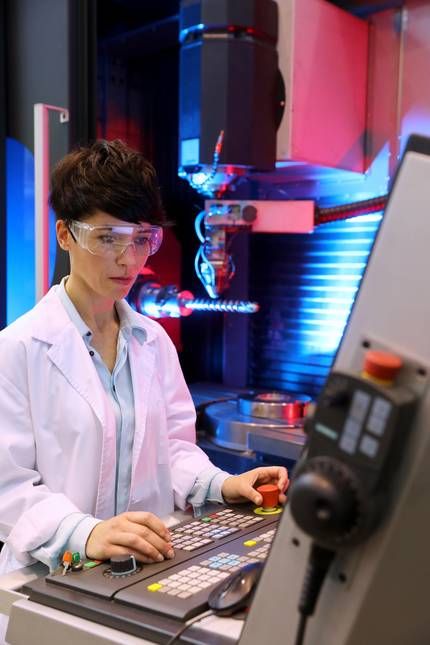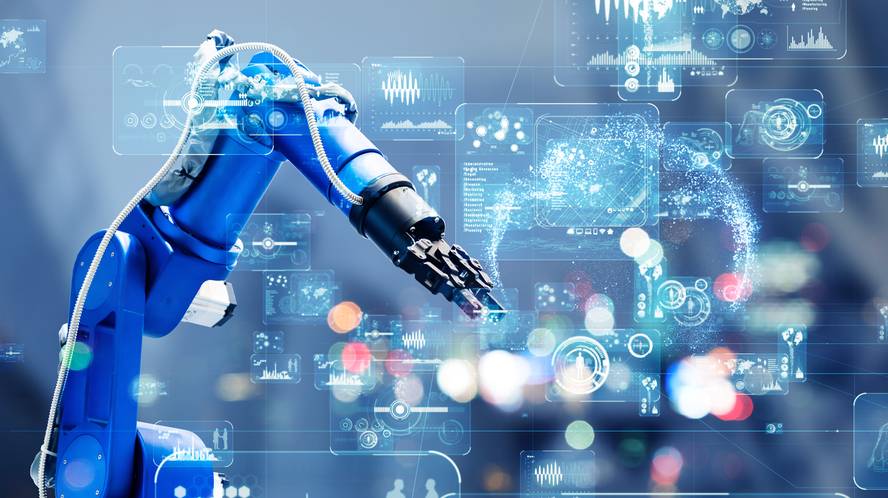“We have a cultural change that will alter the industrial ecosystem”
Industry is undergoing transformation. While digitisation and artificial intelligence have come later than elsewhere, it has already materialised. Intelligent machines are entering the industry, and with it many data engineers. Elhuyar has asked BRTA researchers what the intelligence of industrial machines is and the main challenges have been highlighted: communicating machines intuitively with humans and resolving the data issue.
Just like man is aware of his body, a machine can know when he feels sick. It's machine intelligence. It can detect if something goes wrong in itself, tracking its work. And it also has the ability to decide what it needs to repair itself: it can decide that it needs a lubrication cycle, that a tool is wearing out and you have to change it, or that it has to do a diamond cycle to sharpen the tool. They will also be able to know whether the jobs they have programmed are being properly executed and, where appropriate, how to correct manufacturing defects.
Intelligent machines are machines close to human capacity. But in addition to self-diagnosis and self-positioning, they're required to be able to communicate. Workshops are already becoming intelligent machine ecosystems. Connectivity is therefore key.
That's what smart industry, called industry 4.0, is all about. Digitisation and data provide machines with all these capacitys.Data collection and comparison will provide the machines with the potential to develop all these human capabilities.
BRTA researchers are thoroughly investigating the technologies needed to digitize the industry. “It must be borne in mind that in the CAPV we have a sector that will be critical in the digitization of industry: the machine tool sector. I mean, we make machines. Therefore, we are directly involved in the path of industrial digitalization in the CAPV. We're driving the process forward. And the industry must be aware of this,” explains Jon Kepa Gerrikagoitia, head of science and technology at BRTA.
Intelligent machines will make it possible to optimize performance. The aim is for the industry to be close to continuous production, free from the usual problems that machines are holding back, thanks to the ability of machines to predict problems and constantly adjust themselves. The decision-making capacity of machines has a limitation: what the human being wants to give. You can execute your decision or make it known to the machine operator as a recommendation. You can decide how much autonomy you want to give machines.
Capture, connection, analysis, interaction
%20(1)%20(1)_display_home.jpg)
Mikel Niño, Strategy Manager in Advanced Manufacturing and Industry 4.0, considers that the acquisition of intelligence requires the provision of five major technologies:
First of all, the machine needs the sense of perception to perform a self-diagnosis, competence that will provide the data extraction technology. You will need advanced specific sensors and machine control data acquisition technology.
Secondly, machines, instead of working in isolation, must work interlinked. They must cross variables from different sources of information to know if production is being done correctly, always in real time. So the key is data storage and sharing technology.
On the other hand, it also needs artificial intelligence to contrast all this information that is being generated with models of normality, deduce which variables have led to the deviation of quality and make decisions.
But it also needs interfaces to relate to people in a more intuitive way, to help the worker who works on the production line make the final decision.
The data cycle therefore consists of these four steps: capture, connection, analysis and interaction. But throughout the cycle, there's a fifth indirect factor: safety. The establishment of cyber-secure connections will only allow the real progress of the digital industry.
Data, central topic of discussion
The machine uses the data obtained during production for continuous self-diagnosis. They are also supplied by intelligent machine manufacturers. Artificial intelligence needs constant data to learn, and it is essential that data transmission is effective and safe. There's a prior question of data ownership to solve.
“Data is not a simple issue. The rules for the game are currently being defined. Software has grown very fast in other areas, but in the industrial sphere there have been no data standards. This lack of standards has posed a serious problem in data sharing and great work has been needed to work on these industrial standards, without which it is very difficult to advance in digitisation and artificial intelligence,” says Gerrikagoitia. “It’s the main bleeding to implant a smart industry,” in the same line, Child.

“At the BRTA technology centers we are working on all these five technology bases of the intelligent industry,” Gerrikagoitia. “We are working to make industrial sense of these digital technologies. We are closely linked to the industrial sector and we know very closely the problems of factories,” explains Niño.
The smart industry has many challenges for the future. “At the same time that machines acquire intelligence, one of the greatest challenges is to put the person at the center, even if it seems contradictory. In order to further develop the capabilities of smart algorithms, it is necessary that people communicate to the machine that in a particular situation a significant variable is not being considered. The person must reconfigure the machine to correct the slogans. Therefore, it is imperative that this two-way communication is very intuitive, implying almost the very form of human communication,” says Niño.
“We have another challenge as important as the previous one: there comes a great cultural change that will demand a change in our way of working. Data is useless if we don't trust data and machines. We put obstacles ourselves. Once this cultural change has taken place, the industrial ecosystem will change dramatically, I am sure,” says Gerrikagoitia.




_display_home.jpg)


